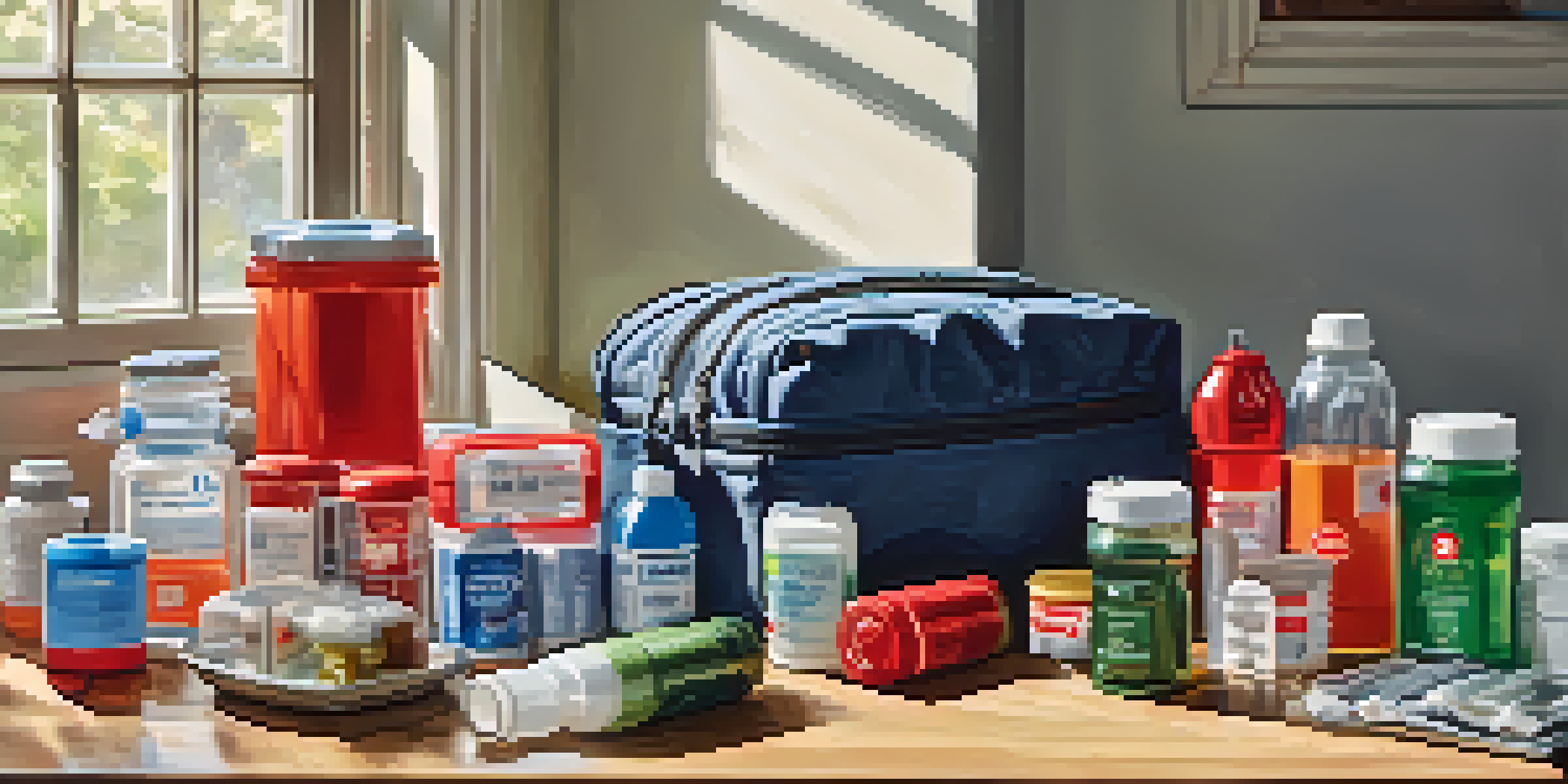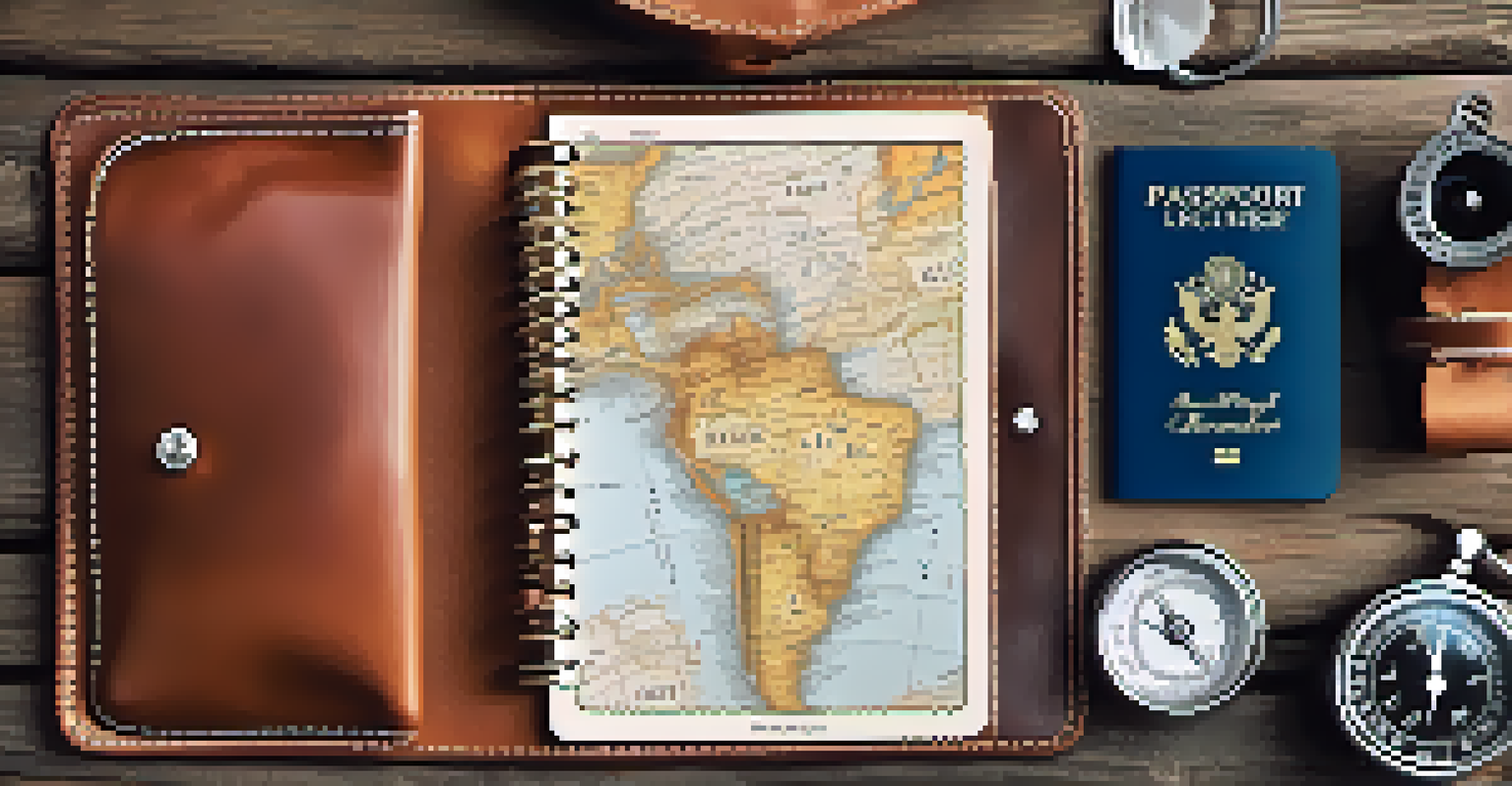Emergency Kits: What to Pack for Safe Travel During Crises

Understanding the Importance of Emergency Kits for Travelers
Traveling is often an adventure, but it's essential to be prepared for unexpected situations. An emergency kit can be your lifeline during crises, whether you're facing natural disasters, medical emergencies, or sudden travel disruptions. Having the right supplies at hand can make all the difference in ensuring your safety and well-being.
By failing to prepare, you are preparing to fail.
Think of your emergency kit as your travel safety net. Just like you wouldn't go on a long hike without a first aid kit, you shouldn't embark on a trip without being prepared for the unexpected. A well-stocked emergency kit can help you respond effectively to unforeseen events, giving you peace of mind as you explore new places.
In this article, we’ll walk you through what to include in your emergency kit, ensuring you have everything you need for safe travel. Let’s dive into the essentials that will keep you prepared and protected, no matter where your journey takes you.
Basic Supplies: What Every Emergency Kit Should Include
When assembling your emergency kit, start with the basics that everyone should have. This includes items like water, non-perishable food, and a flashlight. These supplies will keep you hydrated and nourished, while the flashlight can help you navigate during power outages or in low-light situations.

Additionally, don’t forget a first aid kit, which is crucial for treating minor injuries that might occur. Look for a kit that includes bandages, antiseptics, and pain relievers. Having these essentials on hand can help you address injuries promptly and avoid complications.
Essential Items for Safety
An emergency kit should include basic supplies like water, food, and a first aid kit to ensure safety during unforeseen situations.
Lastly, consider adding a multi-tool or Swiss Army knife, which can be invaluable for various tasks, from opening cans to fixing gear. The right tools can simplify many situations, making your emergency kit not just a collection of supplies, but a practical resource for managing crises effectively.
Personal Medications and Health Essentials in Your Kit
If you take prescription medications, including them in your emergency kit is non-negotiable. Always pack a sufficient supply to cover the duration of your trip, plus a few extra days, just in case. This ensures that you won't run out during unforeseen delays or emergencies.
An ounce of prevention is worth a pound of cure.
Along with your prescription medications, consider including over-the-counter medications for common ailments. These can range from pain relievers and antihistamines to antacids and cold medicine. Having these on hand can help you manage minor health issues that could arise while traveling.
Additionally, if you have specific health needs, such as allergies or diabetes, pack any necessary supplies, like an EpiPen or glucose monitor. Tailoring your emergency kit to your health requirements is crucial for maintaining your safety and comfort during crises.
Communication Tools: Staying Connected During Emergencies
In today’s connected world, having communication tools in your emergency kit is vital. Consider packing a portable phone charger and a power bank to ensure your devices stay functional. This way, you can stay in touch with loved ones or access important information during a crisis.
Additionally, don't forget a printed list of emergency contacts. While your phone is convenient, it could run out of battery or get lost. Having a physical copy of contact information can be a lifesaver when you need to reach out for help.
Stay Connected in Crises
Incorporating communication tools like a portable charger and printed emergency contacts can help you stay connected during emergencies.
Lastly, consider including a whistle or signal mirror in your kit. These items can help you attract attention if you're in a situation where you need assistance but can't easily call for help. Staying connected and visible can significantly increase your chances of getting the help you need.
Shelter and Warmth: Preparing for Outdoor Emergencies
If you find yourself in a situation where you need to seek shelter, having the right gear can make all the difference. A compact emergency blanket or mylar space blanket is lightweight and can provide warmth in cold conditions. This is particularly useful if you're stranded outdoors or in an unheated space.
Additionally, consider packing a lightweight tarp or emergency bivvy bag. These items can help create temporary shelter from the elements, protecting you from rain, wind, or extreme temperatures. Being prepared for the weather can enhance your comfort and safety during emergencies.
Finally, a portable stove or heat source can be invaluable for cooking food or boiling water. Ensure that you have appropriate fuel for your stove, and practice using it before your trip. Having this equipment can help you maintain your energy and morale during trying times.
Navigational Aids: Finding Your Way When Technology Fails
In the event that your phone battery dies or GPS signals are lost, having navigational aids is essential. A physical map of the area you're traveling in can guide you to safety when technology fails. Familiarize yourself with the map beforehand, so you know how to use it effectively.
Additionally, consider including a compass in your emergency kit. While it may seem old-fashioned, a compass can help you maintain your sense of direction, especially in unfamiliar terrain. Knowing how to use a compass alongside a map can be a valuable skill during emergencies.
Regularly Update Your Kit
Regularly reviewing and updating your emergency kit ensures that supplies remain effective and tailored to your travel needs.
Lastly, take the time to learn basic navigation skills before your trip. Understanding how to read maps and use a compass can empower you and boost your confidence should you ever find yourself needing to navigate without digital tools.
Important Documents: Keeping Your Identity Safe
In any emergency, protecting your identity is crucial. Start by packing copies of important documents such as your passport, driver’s license, insurance information, and any necessary medical documents. Having these copies readily available can simplify processes, especially if your originals are lost or damaged.
Consider using a waterproof pouch to protect these documents from the elements. This small investment can save you a lot of stress if you encounter inclement weather or accidental spills. Keeping your documents safe and dry should be a top priority.

Lastly, consider storing these documents digitally as well. Uploading copies to a secure cloud service can allow access from anywhere, providing an additional layer of safety. With both physical and digital backups, you can travel with confidence, knowing your identity is secure.
Reviewing and Updating Your Emergency Kit Regularly
As you prepare your emergency kit, remember that it’s not a one-time task. Regularly reviewing and updating your kit ensures that all items are in good condition and that supplies have not expired. This simple practice can help you remain prepared and avoid a last-minute scramble before a trip.
Set a reminder to check your kit every six months or before major trips. Look for expired food, worn-out supplies, or items that may need replacing. This way, you can feel confident that your kit is reliable when you need it most.
Additionally, consider tailoring your kit to upcoming trips. If you're heading to a tropical location, you might want to include mosquito repellent, while a winter trip may require additional warmth supplies. Customizing your kit for each journey can make your emergency preparedness even more effective.